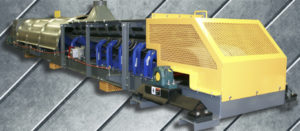Bucket Elevator
Bucket elevators are used to handle fine free-flowing materials including materials with large lumps. There are three configurations of bucket elevators; centrifugal, continuous and twin axis type units. The centrifugal bucket elevator travels at speeds high enough to discharge material by centrifugal force as it passes around the head pulley. Continuous bucket elevators travel at lower speeds and allow for minimum material degradation and reduced wear on equipment as the unit discharges over the head pulley. The twin axis bucket elevator typically travels in the horizontal and vertical directions, to not only lift material, but to convey it horizontally, and at times with multiple discharge points.
Belt Conveyor
 The belt conveyor is a very common way to move bulk solid materials. These units can have multiple inlets and typically have a single discharge. The units can travel horizontally and can have at the most, two bends in the system. These conveyors can travel on roller idlers or across a slider deck. Applications for this type of equipment can be from sanitary food grade across the spectrum to heavy duty high tonnage mineral applications. Units can be open style construction or fully enclosed, and even enclosed in gallery configurations.
The belt conveyor is a very common way to move bulk solid materials. These units can have multiple inlets and typically have a single discharge. The units can travel horizontally and can have at the most, two bends in the system. These conveyors can travel on roller idlers or across a slider deck. Applications for this type of equipment can be from sanitary food grade across the spectrum to heavy duty high tonnage mineral applications. Units can be open style construction or fully enclosed, and even enclosed in gallery configurations.
Screw Conveyor
Screw conveyors convey material using a rotating helix on a pipe shaft. As with all conveyor type applications, a screw conveyor must be uniformly fed at the inlet and will discharge at the in feed rate. A screw conveyor can have multiple inlets and multiple discharge points and is fully enclosed for a dust tight application.
Bucket Conveyor
The bucket conveyor is a variation of the twin axis bucket elevator conveyor. This conveyor needs to have a metered feed and carries the material in discrete buckets that overlap to avoid material spilling between the buckets. Buckets are conveyed with the chain and can have multiple inlets and multiple outlets. They can handle food products and hot heavy minerals.
Flexible Screw
The flexible screw conveyor is a lower volume conveying device compared to a typical screw conveyor. The typical screws are 2”-6” diameter and are limited to about 35 feet in conveying length. The screw is a spring type helix without a shaft and can be used to convey material horizontally and at an incline, and can include a bend in the system.
Vibrating Conveyor
 Vibrating conveyors offer a unique solution to conveying difficult to handle dry solid materials. These conveyors are extremely flexible and can handle fine powders up to large chunks including casting pieces, refuge materials and pieces of lumber. There are no moving parts in the conveying area with the drive mechanism external to the vibrating pan. The system uses low energy to vibrate the pan on a set of springs allowing the spring action to propel the material forward in a pitch and catch action. Creatively, we can spiral the conveying pan upward to allow for further retention time to allow the material to cool while simultaneously elevating it.
Vibrating conveyors offer a unique solution to conveying difficult to handle dry solid materials. These conveyors are extremely flexible and can handle fine powders up to large chunks including casting pieces, refuge materials and pieces of lumber. There are no moving parts in the conveying area with the drive mechanism external to the vibrating pan. The system uses low energy to vibrate the pan on a set of springs allowing the spring action to propel the material forward in a pitch and catch action. Creatively, we can spiral the conveying pan upward to allow for further retention time to allow the material to cool while simultaneously elevating it.
Flexible Wall
A flexible wall conveyor is a standardized belt conveyor with an integral corrugated sidewall and cross cleat molded into the belt. This allows material to be retained easily on the belt while conveying it horizontally or up an incline. These conveyors can have multiple inlets but only one outlet. A variation of this unit can use a nub belt top to incline high volumes of material with high belt speeds.